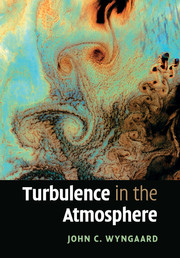Book contents
- Frontmatter
- Contents
- Preface
- Part I A grammar of turbulence
- 1 Introduction
- 2 Getting to know turbulence
- 3 Equations for averaged variables
- 4 Turbulent fluxes
- 5 Conservation equations for covariances
- 6 Large-eddy dynamics, the energy cascade, and large-eddy simulation
- 7 Kolmogorov scaling, its extensions, and two-dimensional turbulence
- Part II Turbulence in the atmospheric boundary layer
- Part III Statistical representation of turbulence
- Index
6 - Large-eddy dynamics, the energy cascade, and large-eddy simulation
from Part I - A grammar of turbulence
Published online by Cambridge University Press: 11 April 2011
- Frontmatter
- Contents
- Preface
- Part I A grammar of turbulence
- 1 Introduction
- 2 Getting to know turbulence
- 3 Equations for averaged variables
- 4 Turbulent fluxes
- 5 Conservation equations for covariances
- 6 Large-eddy dynamics, the energy cascade, and large-eddy simulation
- 7 Kolmogorov scaling, its extensions, and two-dimensional turbulence
- Part II Turbulence in the atmospheric boundary layer
- Part III Statistical representation of turbulence
- Index
Summary
Introduction
As we have seen, the huge range of spatial scales in large-Rt turbulent flows makes it impossible to solve their equations of motion numerically. In applications we use ensemble- or space-averaged equations that have a drastically reduced range of scales. In Chapter 3 we saw that this averaging produces new terms involving turbulent fluxes, and in Chapter 5 we discussed the evolution equations for the fluxes produced by ensemble averaging.
In this chapter we discuss the space-averaged equations further, present the evolution equations for their fluxes, and discuss the modeling of these fluxes. This modeling is of two broad types depending on the spatial scale Δ of the averaging relative to the size ℓ of the energy-containing eddies. In what we shall call “coarse resolution” applications Δ ≫ ℓ in “fine resolution” ones Δ ≪ ℓ.
The first numerical solutions of the averaged equations in meteorology appear to be those of Charney et al. (1950). The domain was a limited area of the earth's surface with 15 × 18 grid squares each 736 km on a side, with only one level in the vertical. The study of Phillips (1955, 1956) soon followed. Its spatial resolution was similarly coarse, but it had two grid levels in the vertical. By the 1970s general circulation models were being used fairly widely, and “mesoscale” or “limited area” models were being used in regional domains. Computer size and speed had grown substantially since the 1950s, but these newer models were still in the coarseresolution category.
- Type
- Chapter
- Information
- Turbulence in the Atmosphere , pp. 115 - 144Publisher: Cambridge University PressPrint publication year: 2010



